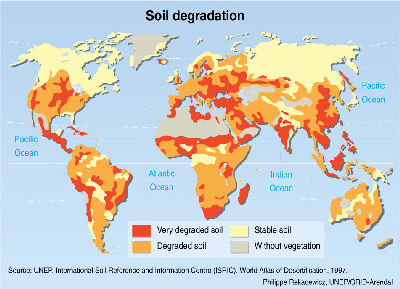1. Soil Degradation
What is soil?
Soil is the upper layer of the Earth's surface. It is made up of small particles that rest on the rocky layer underneath the soil. Depending on the amount of air-spaces between the particles, the soil can be more sandy (when there are big and many gaps) or more like clay (with few and small gaps). Clay soil is holding more water than sandy soil, as there is not as much space for the water to flow through particles. In addition, the surface of the clay soil particles is more capable of holding on to nutrients that are essential for the growth of vegetation.
Soil quality
Soil quality can be described as "the capacity to function", a definition which reflects the living and dynamic nature of soil (Karlet et. al., 1997). It is taking three factors into account, namely, sustained biological productivity, environmental quality, and plant and animal health. When it comes to growing any type of vegetation, a good soil quality suggests that the soil is able to hold sufficient water and nutrients for the plants to grow. Clay soils have a higher holding capacity for both water and nutrients and are considered more fertile than sandy soils.
Soil degradation
Soil degradation can be defined as the process(es) by which the soil loses some characteristics and declines in quality, becoming less fit for specific purposes, such as crop production. Soil degradation can occur through a number of processes. Some of the main ones are: soil erosion, desertification, salinisation, acidification, organic and nutrient depletion and compaction. Those processes are interlinked to some extend and collectively cause soil and land degradation.
GLASOD programme
The GLASOD programme (Global Assessment of Human-Induced Soil Degradation) set out to map global soil degradation in the 1980s. It collected information from experts around the world, on the soil degradation in countries or regions they were familiar. The results showed that erosion by water was by far the more prominent degradation feature worldwide, followed by physical and chemical deterioration, as well as soil fertility decline and soil pollution. The National Soil Degradation Maps by Food and Agriculture Organisation of the United Nations (FAO/AGL) has created an interactive version of the findings of GLASOD, which is available online.

Source: United Nations Environmental Programme - GRID)
Even though GLASOD was the first global study on the issue, it had two major weaknesses. It was based on subjective opinions and hence, it was biased, and it was focusing on spectacular soil problems, such as erosion.
In 1992 the UN Convention to Combat Desertification, supported by GLASOD's findings and concentrating particularly on desertification, was signed at the United Nations Conference on the Environment and Development. While land degradation is not confined to desertification, this convention placed land degradation processes firmly on the global agenda for addressing negative environmental trends. Estimates of land-use degradation rates are even more uncertain than estimates of the extent of degradation, varying from 5 to 10 million hectares a year (Scherr and Yadav 1996).
